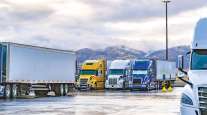Mandates, E-Commerce and Congestion Complicate Truck Parking Issues
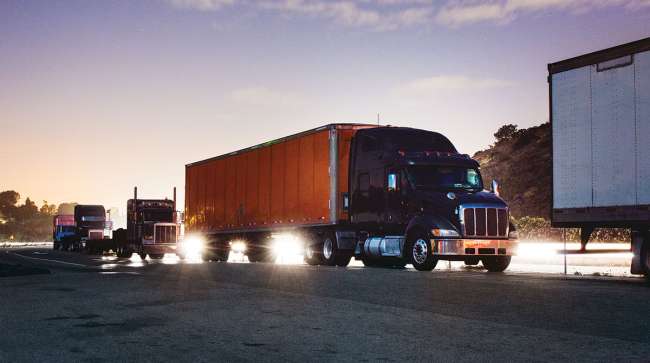
[Stay on top of transportation news: Get TTNews in your inbox.]
Truck parking, which affects everything from driver satisfaction to cargo security, is a top concern for the trucking industry.
The problem is exacerbated by e-commerce growth, municipal mandates and a lack of dedicated parking funding, particularly in urban areas. However, industry experts suggest a mix of public and private investments, creative solutions from shippers and increased use of technology will help reduce parking challenges.
“There isn’t a day that goes by that a parking issue doesn’t come up, whether it is a driver that can’t find a place to park, or a customer won’t let them park,” said Shawn Brown, vice president of safety for Cargo Transporters, based in Claremont, N.C.
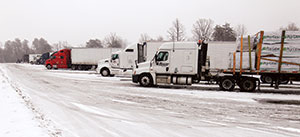
The Henryville Rest Area on Interstate 65 in Henryville, Ind. (John Sommers II for Transport Topics)
Dan Murray, senior vice president of the American Transportation Research Institute (ATRI), said parking demand remains strong. “It is one of those issues that is going to be right there in our face until we make a truly concerted effort to do something,” he said. “There are no short-term solutions to fix it.”
E-commerce growth is driving the demand closer to urban areas, which is a challenge due to population density, zoning restrictions and land cost, said Alexandra Shirk, a research associate for ATRI. Murray added that some cities are cracking down on parking, but the states and municipalities often find themselves “on the other side of the fence when it comes to fighting or enhancing the truck parking opportunities.”
William Elovirta, director of enforcement programs for the Commercial Vehicle Safety Alliance, said there has been a push within urban planning to reduce parking spaces for trucks and cars. “I don’t think we’re seeing a huge effort on the local and the state level for an organized push for truck parking in the same sense of the other priorities,” he said.
Brandon Harrison, president of the over-the-road division for Salt Lake City-based C.R. England, said parking concerns continue to grow near highly populated regions where most freight is picked up and delivered. “Late afternoon and evening hours continue to be some of the most challenging times for drivers to find parking availability,” he said.
C.R. England ranks No. 25 on the Transport Topics Top 100 list of the largest for-hire carriers in North America.
Funding and Recruitment Issues
Many had hoped the Infrastructure Investment and Jobs Act would provide parking funding. Initially, the measure allotted nearly $1 billion in parking funds, but it was dropped. When the bill passed, it didn’t include specific truck parking funding. “There is discretionary funding available that can be put toward truck parking solutions,” Shirk said, adding that parking is now competing with roads and bridges, which is a challenge.
While government and the public understand the need to support roads and bridges, Murray said they know the least about truck parking and where it needs to be built.
Minnesota is slated to get about 30% more in federal funding due to the infrastructure bill, and John Hausladen, president of the Minnesota Trucking Association, said the association will continue to push for truck parking to get its fair share. “We’re hopeful that at least there is a pool to work with, but the fact that truck parking was not designated in any of those funds means it continues to battle with every other need,” he said.
That can be a concern in areas such as Minneapolis, which banned parking on streets in residentially zoned areas last year. “As a highly populated urban center, there isn’t a lot of available land to just create truck parking without some sort of incentives or government support that move it forward,” Hausladen said.
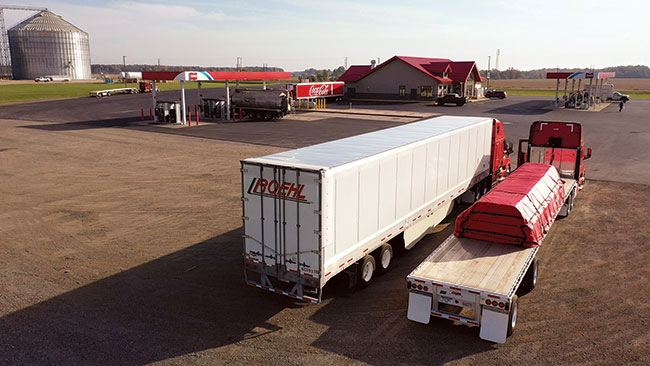
Roehl asks customers for permission to park at their locations. (Roehl Trucking)
The ability to park in residential areas can affect recruiting if drivers don’t have a place to park during their home time. “There are people who want to be truck drivers, but sometimes they can’t become drivers because they don’t know where to park,” said Tim Norlin, vice president of driver employment for Roehl Transport, which is based in Marshfield, Wis., and ranks No. 73 on the TT 100.
Fleets have focused on home time to aid in recruitment.
“More than half of our drivers are home every week. If other carriers are doing the same thing, it is compounding that issue,” Norlin said, adding that truck parking conversations start during the recruiting process. “We try to find out what the plan is and if it is to park in the street in front of their house. It is getting more and more challenging, and it is not just the major metro areas. A lot of smaller cities don’t want trucks in their parking lots.”
Available parking on the road could help attract new drivers to the industry. “Women are almost 50% of the workforce in general, but in trucking, they are 6.5-8% of drivers. They have told us time and again safety and security is their biggest issue. They need lighting, fences and restrooms,” Murray said.
Technology Solutions
Tiffany Wlazlowski Neuman, vice president of public affairs at Natso, an Alexandria, Va.-based trade association representing the truck stop and travel plaza industry, said travel plazas often run into walls from state and local governments when they try to expand.
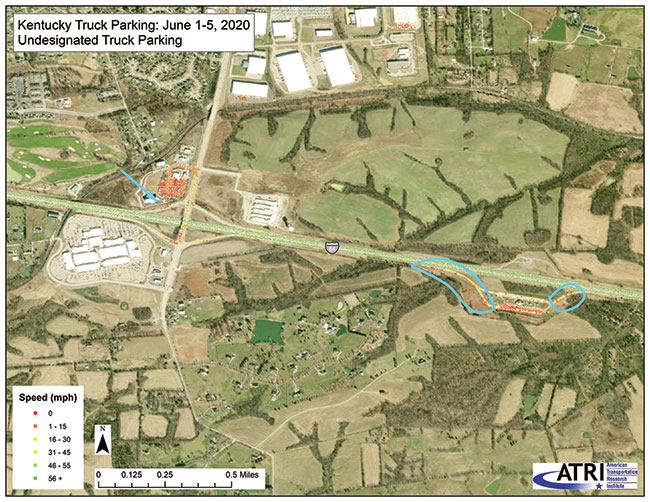
This aerial image, from the Park My Truck app, shows a Kentucky public rest area with parking on the entrance and exit ramps and an exit with a private truck stop. (ATRI)
“They face environmental issues, zoning issues, permitting restrictions and local citizen concerns that prevent them from advancing truck parking projects,” she said. “Sometimes there isn’t real estate available for purchase or the cost of the land is too expensive. This is all especially true on the East Coast and in more urban areas.”
Chris Oliver, chief marketing officer for Trucker Path, a truck parking app, said East Coast parking locations are fuller than the West Coast locations due to population density. “There are certainly large metropolitan areas in both the East and the West, but the big difference is the space between those large metro areas,” he said.
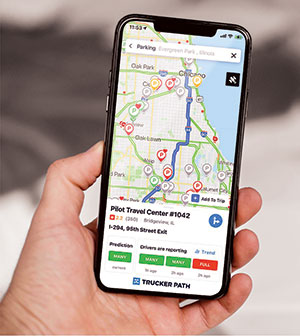
The Trucker Path app uses a crowdsourced approach to capture parking availability directly from commercial drivers. (TruckerPath)
Trucker Path uses a crowdsourced approach to capture parking availability directly from commercial drivers. When users enter truck parking areas, they receive a pop-up question in the app asking if many spaces are available, some spaces are available or the lot is full. “This is made possible via geofences we’ve established around all of the known parking locations,” Oliver said.
Shirk said accurate and up-to-date information is critical, and apps and variable message signs are highly utilized among truck drivers. ATRI, American Trucking Associations and Natso formed the Truck Parking Leadership Initiative, which developed the Park My Truck app that allows truck stops, rest areas and others to report the number of spaces available in their lots.
Establishing Partnerships
Shippers, receivers and distribution centers have a critical role to play in the truck parking situation, and Brown said customers’ role in parking is becoming more of a factor.
“It is so huge that internally we remind our customer service team of the importance of knowing ahead of time places we can and cannot park, so the drivers know,” he said, adding that representatives always ask customers if drivers can park at their locations. “That is as important as the rate.”
Norlin said Roehl asks customers if they can park one or two trucks at their locations or have a driver leave a personal vehicle while hauling freight. “Some customers have been very accommodating, and we remember that and work closely with them,” he said.
The warehouse and the delivery part of the supply chain must be part of the solution, Elovirta said. “From a zoning standpoint, when those facilities are built, should they take parking into account for those folks? It provides a safer environment,” he noted.
Shippers and receivers honoring pickup and delivery times could also help with parking planning, in addition to being creative when scheduling. Even if drivers can park at shippers or receivers’ locations, those facilities don’t offer the amenities drivers need.
“Just because you drive a truck with a sleeper berth, it doesn’t solve your problems for all of life’s basic necessities. You need access to food, restrooms and showers. If you’re not on duty, being able to interact with others,” Hausladen said.
C.R. England communicates parking options around shipping and receiving facilities to drivers in advance. “We also provide our drivers fueling options with every load assignment, working with the truck stops in the country to help provide parking options for our drivers,” Harrison said.
Roehl asks drivers to focus on parking as part of their trip planning. “Don’t just drive to an area and hope to park. Plan or know from experience where to park,” Norlin said, adding that parking in an unsecured area is dangerous from a driver safety aspect but also cargo theft. “It is all about securement. We need a gated, secured location for drivers to park, and it is getting harder and harder for drivers to find.”
Neuman said one of the best ways to address truck parking capacity concerns is for fleets to negotiate truck parking in the same way they negotiate fuel contracts. “Truck stops and travel plazas are highly responsive to customer demand,” she said.
Hausladen said that while nobody wants to pay more, there is a willingness to pay for truck parking if it is guaranteed, safe and reasonably accessible.
Tammy Anderson, vice president of marketing and operations at Terminal Exchange Services, said thieves are always looking for cargo. Terminal Exchange Services offers 2,500 locations, including gated, secure locations for fleets with high-value loads. The sites don’t offer amenities, but restrooms, restaurants and hotels are typically located within a mile.
Want more news? Listen to today's daily briefing above or go here for more info
ATRI’s Murray said the trucking industry needs both public and private parking locations. “In a perfect world, we’d have perfect collaboration where the public sector helps the private sector expand capacity and manage capacity,” he said.
Natso encourages states to explore ways to lower the private sector’s costs to create or expand truck parking, such as tax incentives or land acquisition and maintenance assistance. The association encourages regulators to consider any new regulations’ impact on truck parking. The ELD mandate, for example, changed when drivers drive and park, which in turn impacted the utilization of existing truck parking capacity, Neuman said.
Ultimately, a safe, reliable parking spot makes a happy driver, Brown said. “They can be more productive with their time away from home, make more money and have less stress,” he explained. “A happy driver leads to reduced turnover, and it can bring more drivers into the industry.”




